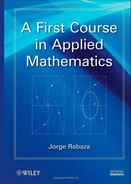CONTENTS
1.3 Dot Product and Orthogonality
1.4.1 Diagonal and triangular matrices
1.4.3 Nonsingular and inverse matrices
1.4.4 Symmetric and positive definite matrices
1.6 Linear Independence and Basis
1.7 Orthogonalization and Direct Sums
1.8 Column Space, Row Space, and Null Space
1.10 Eigenvalues and Eigenvectors
1.12 Bezier Curves and Postscript Fonts
1.12.1 Properties of Bezier curves
1.12.2 Composite Bezier curves
1.13 Final Remarks and Further Reading
2.2 Stochastic, Irreducible, and Primitive Matrices
2.3 Google's PageRank Algorithm
2.3.1 The personalization vector
2.3.2 Speed of convergence and sparsity
2.3.3 Power method and reordering
2.4 Alternatives to the Power Method
2.4.1 Linear system formulation
2.4.2 Iterative aggregation/disaggregation (IAD)
2.5 Final Remarks and Further Reading
3.1.3 The PA = LU factorization
3.3 Singular Value Decomposition (SVD)
3.4.2 Schur factorization and invariant subspaces
3.6 Partition of Simple Substitution Cryptograms
3.7 Final Remarks and Further Reading
4.1 Projections and Normal Equations
4.2 Least Squares and QR Factorization
4.4 Final Remarks and Further Reading
5.1 Compressing with Discrete Cosine Transform
5.1.1 1 -D discrete cosine transform
5.1.2 2-D discrete cosine transform
5.1.3 Image compression and the human visual system
5.1.4 Basis functions and images
5.1.7 Compression of color images
5.3.1 Compressing grayscale images
5.3.2 Compressing color images
5.4 Final Remarks and Further Reading
6 Ordinary Differential Equations
6.1 One-Dimensional Differential Equations
6.1.1 Existence and uniqueness
6.1.2 A simple population model
6.2 Linear Systems of Differential Equations
6.3 Solutions via Eigenvalues and Eigenvectors
6.3.1 Chains of generalized eigenvectors
6.4 Fundamental Matrix Solution
6.5 Final Remarks and Further Reading
7.1.1 Dynamics in two dimensions
7.1.2 Trace-determinant analysis
7.1.3 Stable, unstable, and center subspaces
7.2 Nonlinear Dynamical Systems
7.2.1 Linearization around an equilibrium point
7.2.2 Linearization around a periodic orbit
7.3 Predator–prey Models with Harvesting
7.3.1 Boundedness of solutions
7.3.2 Equilibrium point analysis
7.4 Final Remarks and Further Reading
8.1 Optimization of a Waste Management System
8.1.2 Description of the system
8.1.3 Development of the mathematical model
8.1.4 Building the objective function
8.1.5 Building the constraints
8.2 Grouping Problem in Networks
8.2.3 The probabilistic approach
8.3 American Cutaneous Leishmaniasis
8.3.2 Development of the mathematical model
8.3.3 Equilibria and periodic orbits
8.4 Variable Population Interactions
